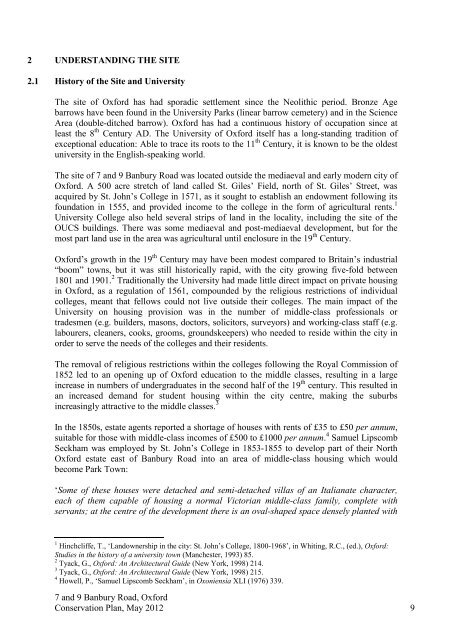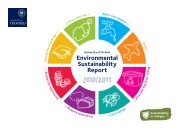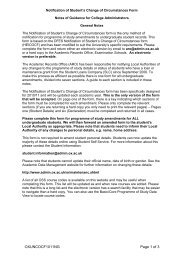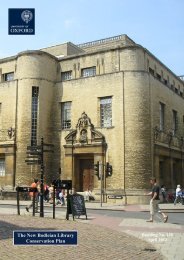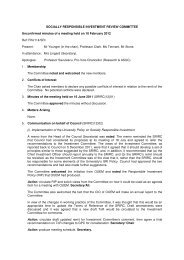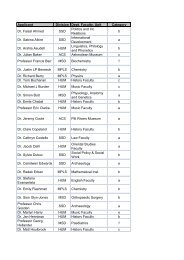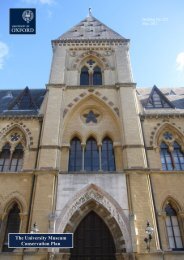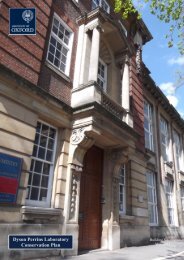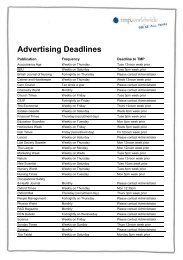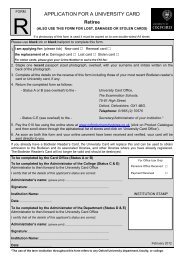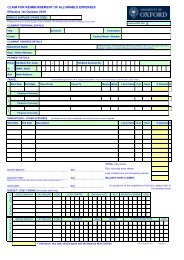7-9 Banbury Road - Central Administration - University of Oxford
7-9 Banbury Road - Central Administration - University of Oxford
7-9 Banbury Road - Central Administration - University of Oxford
You also want an ePaper? Increase the reach of your titles
YUMPU automatically turns print PDFs into web optimized ePapers that Google loves.
2 UNDERSTANDING THE SITE2.1 History <strong>of</strong> the Site and <strong>University</strong>The site <strong>of</strong> <strong>Oxford</strong> has had sporadic settlement since the Neolithic period. Bronze Agebarrows have been found in the <strong>University</strong> Parks (linear barrow cemetery) and in the ScienceArea (double-ditched barrow). <strong>Oxford</strong> has had a continuous history <strong>of</strong> occupation since atleast the 8 th Century AD. The <strong>University</strong> <strong>of</strong> <strong>Oxford</strong> itself has a long-standing tradition <strong>of</strong>exceptional education: Able to trace its roots to the 11 th Century, it is known to be the oldestuniversity in the English-speaking world.The site <strong>of</strong> 7 and 9 <strong>Banbury</strong> <strong>Road</strong> was located outside the mediaeval and early modern city <strong>of</strong><strong>Oxford</strong>. A 500 acre stretch <strong>of</strong> land called St. Giles’ Field, north <strong>of</strong> St. Giles’ Street, wasacquired by St. John’s College in 1571, as it sought to establish an endowment following itsfoundation in 1555, and provided income to the college in the form <strong>of</strong> agricultural rents. 1<strong>University</strong> College also held several strips <strong>of</strong> land in the locality, including the site <strong>of</strong> theOUCS buildings. There was some mediaeval and post-mediaeval development, but for themost part land use in the area was agricultural until enclosure in the 19 th Century.<strong>Oxford</strong>’s growth in the 19 th Century may have been modest compared to Britain’s industrial“boom” towns, but it was still historically rapid, with the city growing five-fold between1801 and 1901. 2 Traditionally the <strong>University</strong> had made little direct impact on private housingin <strong>Oxford</strong>, as a regulation <strong>of</strong> 1561, compounded by the religious restrictions <strong>of</strong> individualcolleges, meant that fellows could not live outside their colleges. The main impact <strong>of</strong> the<strong>University</strong> on housing provision was in the number <strong>of</strong> middle-class pr<strong>of</strong>essionals ortradesmen (e.g. builders, masons, doctors, solicitors, surveyors) and working-class staff (e.g.labourers, cleaners, cooks, grooms, groundskeepers) who needed to reside within the city inorder to serve the needs <strong>of</strong> the colleges and their residents.The removal <strong>of</strong> religious restrictions within the colleges following the Royal Commission <strong>of</strong>1852 led to an opening up <strong>of</strong> <strong>Oxford</strong> education to the middle classes, resulting in a largeincrease in numbers <strong>of</strong> undergraduates in the second half <strong>of</strong> the 19 th century. This resulted inan increased demand for student housing within the city centre, making the suburbsincreasingly attractive to the middle classes. 3In the 1850s, estate agents reported a shortage <strong>of</strong> houses with rents <strong>of</strong> £35 to £50 per annum,suitable for those with middle-class incomes <strong>of</strong> £500 to £1000 per annum. 4 Samuel LipscombSeckham was employed by St. John’s College in 1853-1855 to develop part <strong>of</strong> their North<strong>Oxford</strong> estate east <strong>of</strong> <strong>Banbury</strong> <strong>Road</strong> into an area <strong>of</strong> middle-class housing which wouldbecome Park Town:‘Some <strong>of</strong> these houses were detached and semi-detached villas <strong>of</strong> an Italianate character,each <strong>of</strong> them capable <strong>of</strong> housing a normal Victorian middle-class family, complete withservants; at the centre <strong>of</strong> the development there is an oval-shaped space densely planted with1 Hinchcliffe, T., ‘Landownership in the city: St. John’s College, 1800-1968’, in Whiting, R.C., (ed.), <strong>Oxford</strong>:Studies in the history <strong>of</strong> a university town (Manchester, 1993) 85.2 Tyack, G., <strong>Oxford</strong>: An Architectural Guide (New York, 1998) 214.3 Tyack, G., <strong>Oxford</strong>: An Architectural Guide (New York, 1998) 215.4 Howell, P., ‘Samuel Lipscomb Seckham’, in Oxoniensia XLI (1976) 339.7 and 9 <strong>Banbury</strong> <strong>Road</strong>, <strong>Oxford</strong>Conservation Plan, May 2012 9


